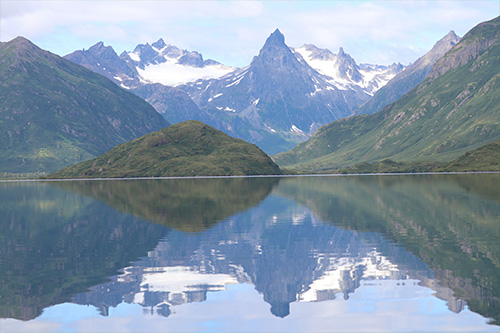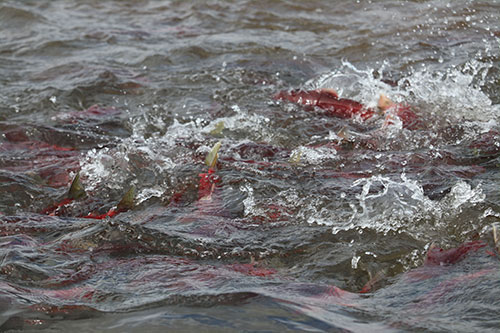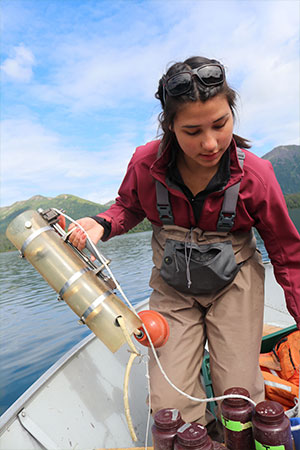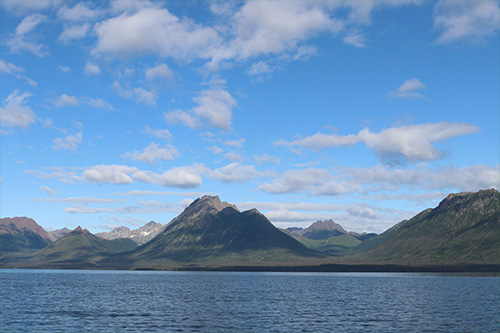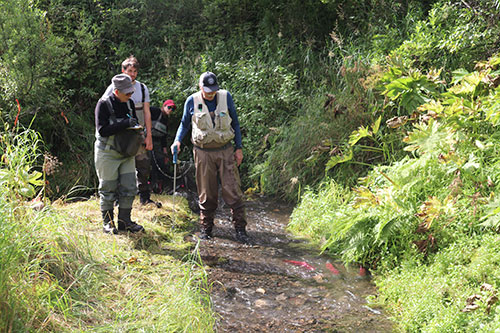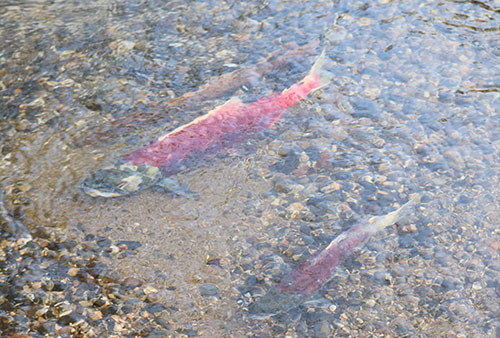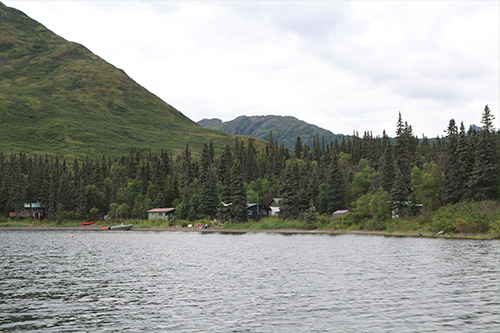
The Salmon StateUpriver during a record year
|
|||||||||||
Kulik Spire, reflected in Kulik Lake, a lake in the Bristol Bay |
I was up at two of the camps — Lake Nerka, (“nerka,” fittingly, is the Russian name for and the second part of the scientific name for sockeye salmon) and Aleknagik (Nerka is known locally as Second Lake and Aleknagik as First Lake). Over the course of my week there, I helped take genetic samples of fish, went all the way up to Kulik Lake (Fifth Lake, the farthest lake salmon can reach in the system), and learned a lot. Every year, even those who have been coming for more than two decades learn something unexpected, said University of Washington Professor of Aquatic and Fisheries Sciences Daniel Schindler, the scientist who was nice enough to invite me along.
Sockeye salmon school up at the mouth of Uno Creek off Beverley Lake in the Bristol Bay watershed on August 10, 2018. |
Regardless of how technology develops, there are things scientists see when they’re present in a watershed that would never come across if they studied, say, by drone.
A few recent surprises? The Wood River system has had some “massive caterpillar outbreaks” in recent years.
Daniel Schindler of the University of Washington’s Alaska Salmon Program in the Bristol Bay watershed, which the program has studied since 1946, on August 9, 2018. |
“Birds, bears, rainbow trout, grayling — all of them are just packed full of caterpillars,” said Schindler.
The caterpillars themselves are packed full of vegetation, which they “obliterate” along the system. By September, though, the alders have re-sprouted instead of turning bright and beginning to die off. To Schindler, that suggests there’s an environmental history of the caterpillars and their interplay on the landscape — something supported by local knowledge.
Danielle Lowrey, a University of Alaska Southeast student and Bristol Bay Native Association intern from Bethel, prepares a Van Dorn, which takes water samples that will later be filtered for algae concentration, on Kulik Lake in the Bristol Bay watershed on August 9, 2018. |
Another surprise: scientists recently began finding foot-long salmon that had clearly been to sea. They looked like sockeye but they were acting like coho, eating sockeye smolts and feeding aggressively in fresh water. After genetic testing, it turns out they were coho.
A third: There’s a plant, kneeling angelica, that appears to bloom in time with the salmon runs — earlier on colder streams, which is the opposite of what you’d expect.
I’m not a scientist, but my time there was packed with things I found interesting: the size of a stream (so narrow and shallow!) that can support salmon. A ground squirrel crossing the stream on the backs of two sockeye. (Crossing a stream on the backs of salmon may be legends of yesteryear in many river systems, but not in Bristol Bay!) Watching a jack sockeye salmon hide a little downstream, staying in place behind a slight barrier, as a female dug a redd. It crept in whenever a full-size male swam off, only to be chased off by both the full-size male and female or either. (Jack salmon, which return to spawn after just one year at sea and are much smaller than the average salmon, engage in some unique mating strategies in order to pass their genes along.)
Another teacher was the watershed itself: as a formerly glaciated landscape, the Wood River lake system offers a great tutorial on what it is that makes optimal salmon habitat.
“One of the reasons Bristol Bay is productive for salmon is the glacial history,” Schindler told me as we boated past Ott Bay, on Lake Nerka. “Valleys are way bigger than the rivers, and there’s lots of gravel left behind.”
That allows streams to wander around, continuously eroding gravel and helping to create yet more salmon habitat. The lack of development in the watershed is also key: the widest valley in the world won’t help a river wander to create and maintain salmon habitat if infrastructure prevents it.
This year, more than 7.5 million sockeye swam up the Wood River, as per the Alaska Department of Fish and Game’s escapement counts. An estimated more than 33.5 million returned to the Wood, Nushagak and Igushik rivers, including both catch and escapement. As a whole, though late sockeye are still being caught and counted, Bristol Bay blew past its record overall return, with more than 62 million fish as of August 2. Those numbers stand out even more compared with the dismal returns in Kodiak, the Copper River, and many others.
For the next “The Salmon State” column, keep an eye out for a story about how animals that eat salmon “surf the salmon wave” as it moves across the landscape. As you read it, even in September, sockeye will still be spawning in the creeks, rivers and lakes of Bristol Bay.
Photo Gallery:
Ott Bay on Lake Nerka, as pictured on August 9, 2018. The mountains and valleys that create the bay are a good - though steep - example of a glaciated landscape, which helps create ideal salmon habitat - low and flat, with a high amount of gravel. |
A creek off Little Togiak |
Sockeye Jack |
Nerka camp |
Mary Catharine Martin ©2018 Mary Catharine Martin [mc@salmonstate.org] is an award-winning science and outdoors writer and the communications director of SalmonState. If you have a story you’d like to suggest for this column, contact her at mc@salmonstate.org. SalmonState, a new initiative with offices in Juneau, Anchorage and Homer, Alaska, works to protect salmon habitat and promote policies that will guarantee Alaska remains the Salmon State: home of the world's largest, healthiest and most abundant wild salmon resource, which provides culture, food, income, employment and recreation to Alaskans, Americans and the rest of the world. |
Representations of fact and opinions in comments posted are solely those of the individual posters and do not represent the opinions of Sitnews.
SitNews ©2018
Stories In The News
Ketchikan, Alaska
Articles & photographs that appear in SitNews may be protected by copyright and may not be reprinted without written permission from and payment of any required fees to the proper sources.
E-mail your news & photos to editor@sitnews.us
Photographers choosing to submit photographs for publication to SitNews are in doing so granting their permission for publication and for archiving. SitNews does not sell photographs. All requests for purchasing a photograph will be emailed to the photographer.
